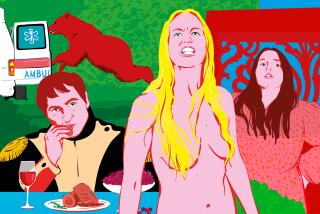Book Review : A Story of Scientists and Science in Human Comedy
Nobel Dreams: Power, Deceit and the Ultimate Experiment by Gary Taubes (Random House: $19.95)
Most books that purport to explain high-energy physics to the interested layman deliver less than they promise. You usually have to know quite a lot about physics to make head or tail of it.
Gary Taubesâ âNobel Dreamsâ explains the physics very clearly, and it would be a good and noteworthy book for that alone. But there is even more to recommend it.
What makes âNobel Dreamsâ especially good is that it is more about people than it is about physics. It is one of those rare science books that tells about science in the course of telling about the human comedy, and Taubes, a science writer who studied physics, has done a masterful job at both.
This is the story of Carlo Rubbia, an experimental physicist who won a Nobel Prize in 1984 for having discovered the W and Z particles in the Europeansâ CERN atom smasher near Geneva. It turns out that Rubbia is a very unpleasant man, by all accounts, as well as a brilliant if erratic physicist.
Stepping on Toes
Taubes paints Rubbia as a driven scientist who bullied his way to a Nobel Prize by hook and crook and a lot of luck, who stepped on many toes in the unbridled pursuit of that special telegram from the Swedish Academy, which he got once but failed at a second time.
The Nobel Prize is the Academy Award of science, but, if it is possible, scientists pursue the Nobel more ferociously and single-mindedly than movie people pursue Oscars. Neither Taubes nor any of the people in his book ever questions the Nobel Prize as the alpha and the omega of science. No one seems to question what all the hoopla is about.
âNobel Dreamsâ is extraordinarily revealing about science and scientists. It is also very timely, as the United States must now decide whether to build a supercollider to dwarf all previous atom smashers, 52 miles in circumference and expected to cost $6 billion by the time it is built a decade from now.
Taubes explains what high-energy physicists actually do with those colliders. He takes the reader into the control room of the CERN atom smasher and lets him look into the heart of physics as protons collide with antiprotons at velocities near the speed of light.
The physicists pore over pages of computer printouts looking for the one collision in a billion that has produced an interesting particle, which existed for an infinitesimally small fraction of a second before decomposing into something else. When the physicists find the something else amid the detritus of the collisions, they infer that the long-sought particle actually exists, as predicted by one theory of matter or another.
Rests on Belief, Too
Science is the effort to understand the world through reason, but science itself rests on belief no less than religion does. Scientists believe, for example, that the scientific method is the way to arrive at truth, and they also believe that simple explanations are preferable to complicated ones, though there is no inherent reason why the universe should be simple.
Yet scientists prefer simplicity, which is why the current state of theoretical physics leaves many of them unhappy. Itâs too complicated. There are too many particles in the theory, and new ones invented all the time, though it begins to look like Ptolemyâs epicycles for making his incorrect model of the solar system coincide with observations of planets in the sky.
It took Copernicus to straighten out our model of the universe, and some theoretical physicists, at least, are wondering whether physics needs a Copernicus to straighten out their model of the nature of matter.
Of course, it may also be the case that physics isnât really beautiful at all and that there is no grand unifying theory or simplifying scheme. Perhaps physicists who think that there should be one are making the same mistake that Johann Kepler made when he observed that there were five planets and five regular solids and concluded that those two facts must be connected. (They arenât, and we now know that there are at least nine planets.)
In the Big Leagues
The answers to these and other questions yet unasked cannot be known without building larger machines, which will smash matter together at yet higher energies and speeds and produce more particles to bedevil the theorists. Taubes does not spend much time wondering why people want to know these things, but he makes clear that many scientists spare no time or effort to find out the answers. In the big leagues of science, the players play hardball.
Taubes does for high-energy physics what James Watson did for biology. He pulls back the curtain and portrays scientists as human beings driven by the same irrational passions as drive everyone else.
Most science books tell you about science. They are interesting to people who want to know about that particular subject. âNobel Dreamsâ is about people. It should be interesting to everyone.
More to Read
Sign up for Essential California
The most important California stories and recommendations in your inbox every morning.
You may occasionally receive promotional content from the Los Angeles Times.










